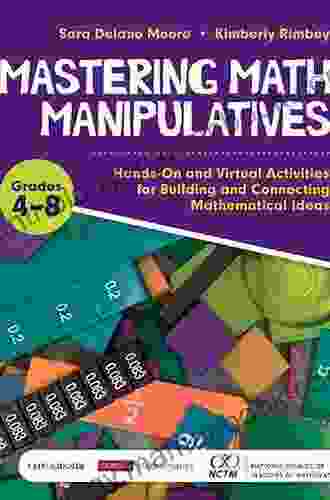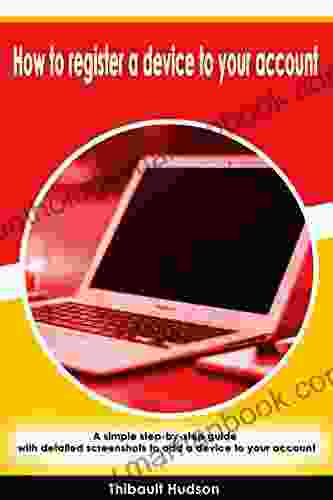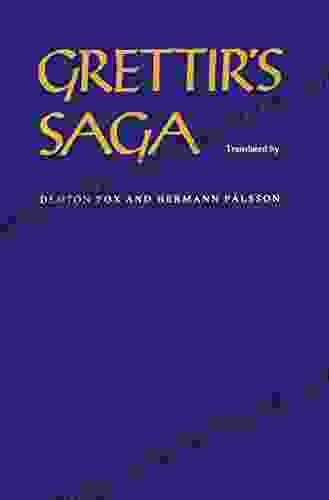Mastering Math Manipulatives Grades: A Comprehensive Guide

Math manipulatives are physical objects that can be used to represent mathematical concepts and operations. They provide students with a hands-on way to learn math, which can help them to develop a deeper understanding of the subject. Manipulatives can be used in a variety of ways, such as to:
5 out of 5
| Language | : | English |
| File size | : | 61057 KB |
| Text-to-Speech | : | Enabled |
| Enhanced typesetting | : | Enabled |
| Word Wise | : | Enabled |
| Screen Reader | : | Supported |
| Print length | : | 320 pages |
| X-Ray for textbooks | : | Enabled |
- Represent numbers and quantities
- Explore patterns and relationships
- Solve problems
- Develop computational skills
- Build spatial reasoning skills
There are many different types of math manipulatives available, and each type can be used for a variety of purposes. Some of the most common types of manipulatives include:
- Blocks
- Base ten blocks
- Counters
- Dice
- Fraction circles
- Geoboards
- Pattern blocks
- Tangrams
Benefits of Using Math Manipulatives
There are many benefits to using math manipulatives in the classroom. Some of the most well-documented benefits include:
- Improved student engagement: Manipulatives can help to make math more fun and engaging for students. They provide a hands-on way to learn, which can help to keep students motivated and interested in the subject.
- Deeper understanding of mathematical concepts: Manipulatives can help students to develop a deeper understanding of mathematical concepts. They provide a concrete representation of abstract ideas, which can help students to make connections between different concepts and to see how they relate to each other.
- Improved problem-solving skills: Manipulatives can help students to develop problem-solving skills. They can use manipulatives to represent problems and to explore different solutions. This can help them to develop a better understanding of the problem-solving process and to become more confident in their ability to solve problems.
- Enhanced spatial reasoning skills: Manipulatives can help students to develop spatial reasoning skills. They can use manipulatives to represent shapes and to explore spatial relationships. This can help them to develop a better understanding of geometry and to become more confident in their ability to solve spatial problems.
- Improved communication skills: Manipulatives can help students to develop communication skills. They can use manipulatives to explain mathematical concepts to others. This can help them to develop their ability to communicate clearly and effectively.
How to Use Math Manipulatives
There are many different ways to use math manipulatives in the classroom. Some of the most effective ways to use manipulatives include:
- Use manipulatives to represent mathematical concepts. This can help students to develop a deeper understanding of the concepts and to see how they relate to each other.
- Use manipulatives to solve problems. This can help students to develop problem-solving skills and to become more confident in their ability to solve problems.
- Use manipulatives to explore patterns and relationships. This can help students to develop critical thinking skills and to see how different mathematical concepts are related.
- Use manipulatives to build spatial reasoning skills. This can help students to develop a better understanding of geometry and to become more confident in their ability to solve spatial problems.
- Use manipulatives to develop communication skills. This can help students to develop their ability to communicate clearly and effectively.
It is important to note that manipulatives should not be used as a replacement for traditional math instruction. Instead, they should be used as a supplement to instruction. Manipulatives can help to make math more concrete and engaging for students, but they should not be used as the only way to teach math.
Math Manipulatives for Specific Grade Levels
The types of math manipulatives that are appropriate for use in the classroom will vary depending on the grade level. Some of the most common manipulatives for each grade level include:
- Kindergarten: Blocks, counters, dice, pattern blocks, tangrams
- Grade 1: Base ten blocks, fraction circles, geoboards, pattern blocks, tangrams
- Grade 2: Base ten blocks, fraction circles, geoboards, pattern blocks, tangrams, algebra tiles
- Grade 3: Base ten blocks, fraction circles, geoboards, pattern blocks, tangrams, algebra tiles, protractors
- Grade 4: Base ten blocks, fraction circles, geoboards, pattern blocks, tangrams, algebra tiles, protractors, compasses
- Grade 5: Base ten blocks, fraction circles, geoboards, pattern blocks, tangrams, algebra tiles, protractors, compasses, calculators
- Grade 6: Base ten blocks, fraction circles, geoboards, pattern blocks, tangrams, algebra tiles, protractors, compasses, calculators, graphing calculators
- Grade 7: Base ten blocks, fraction circles, geoboards, pattern blocks, tangrams, algebra tiles, protractors, compasses, calculators, graphing calculators, scientific calculators
- Grade 8: Base ten blocks, fraction circles, geoboards, pattern blocks, tangrams, algebra tiles, protractors, compasses, calculators, graphing calculators, scientific calculators, rulers
- Algebra I: Base ten blocks, fraction circles, geoboards, pattern blocks, tangrams, algebra tiles, protractors, compasses, calculators, graphing calculators, scientific calculators, rulers, compasses
- Geometry: Geoboards, pattern blocks, tangrams, algebra tiles, protractors, compasses, rulers, compasses, protractors
- Algebra II: Base ten blocks, fraction circles, geoboards, pattern blocks, tangrams, algebra tiles, protractors, compasses, calculators, graphing calculators, scientific calculators, rulers, compasses, protractors
- Pre-Calculus: Base ten blocks, fraction circles, geoboards, pattern blocks, tangrams, algebra tiles, protractors, compasses, calculators, graphing calculators, scientific calculators, rulers, compasses, protractors
- Calculus: Base ten blocks, fraction circles, geoboards, pattern blocks, tangrams, algebra tiles, protractors, compasses, calculators, graphing calculators, scientific calculators, rulers, compasses, protractors
Math manipulatives are a valuable tool that can be used to enhance math instruction and student learning. They provide a hands-on way to learn math, which can help students to develop a deeper understanding of the subject. Manipulatives can also help students to develop problem-solving skills, spatial reasoning skills, and communication skills. By using manipulatives effectively, teachers can help students to succeed in math and to develop a lifelong love of learning.
5 out of 5
| Language | : | English |
| File size | : | 61057 KB |
| Text-to-Speech | : | Enabled |
| Enhanced typesetting | : | Enabled |
| Word Wise | : | Enabled |
| Screen Reader | : | Supported |
| Print length | : | 320 pages |
| X-Ray for textbooks | : | Enabled |
Do you want to contribute by writing guest posts on this blog?
Please contact us and send us a resume of previous articles that you have written.
 Top Book
Top Book Novel
Novel Fiction
Fiction Nonfiction
Nonfiction Literature
Literature Paperback
Paperback Hardcover
Hardcover E-book
E-book Audiobook
Audiobook Bestseller
Bestseller Classic
Classic Mystery
Mystery Thriller
Thriller Romance
Romance Fantasy
Fantasy Science Fiction
Science Fiction Biography
Biography Memoir
Memoir Autobiography
Autobiography Poetry
Poetry Drama
Drama Historical Fiction
Historical Fiction Self-help
Self-help Young Adult
Young Adult Childrens Books
Childrens Books Graphic Novel
Graphic Novel Anthology
Anthology Series
Series Encyclopedia
Encyclopedia Reference
Reference Guidebook
Guidebook Textbook
Textbook Workbook
Workbook Journal
Journal Diary
Diary Manuscript
Manuscript Folio
Folio Pulp Fiction
Pulp Fiction Short Stories
Short Stories Fairy Tales
Fairy Tales Fables
Fables Mythology
Mythology Philosophy
Philosophy Religion
Religion Spirituality
Spirituality Essays
Essays Critique
Critique Commentary
Commentary Glossary
Glossary Bibliography
Bibliography Index
Index Table of Contents
Table of Contents Preface
Preface Introduction
Introduction Foreword
Foreword Afterword
Afterword Appendices
Appendices Annotations
Annotations Footnotes
Footnotes Epilogue
Epilogue Prologue
Prologue Stella Marie Alden
Stella Marie Alden Brian Shea
Brian Shea Gauri Kolhe
Gauri Kolhe J L Brown
J L Brown Geoffrey Darnton
Geoffrey Darnton Kristi Bradley
Kristi Bradley Meredith G Farkas
Meredith G Farkas John G Hemry
John G Hemry Sachin Narayan Kadam
Sachin Narayan Kadam Azra Raza
Azra Raza Pat Nicholson
Pat Nicholson Wayne Luckmann
Wayne Luckmann John Macgregor Cfp
John Macgregor Cfp Todd Whitaker
Todd Whitaker Samantha Clark
Samantha Clark Tito Rajarshi Mukhopadhyay
Tito Rajarshi Mukhopadhyay Mark E Russinovich
Mark E Russinovich L Frank Baum
L Frank Baum Sanjoy Ganguly
Sanjoy Ganguly Susan Perry
Susan Perry
Light bulbAdvertise smarter! Our strategic ad space ensures maximum exposure. Reserve your spot today!

 H.G. WellsPlotting Forex Support and Resistance: A Comprehensive Guide for Discovering...
H.G. WellsPlotting Forex Support and Resistance: A Comprehensive Guide for Discovering...
 Kenneth ParkerPanis Angelicus Cesar Franck Piano Accompaniment Only Major Medium Level...
Kenneth ParkerPanis Angelicus Cesar Franck Piano Accompaniment Only Major Medium Level... Caleb LongFollow ·19k
Caleb LongFollow ·19k Edward BellFollow ·11.9k
Edward BellFollow ·11.9k Hugo CoxFollow ·2.4k
Hugo CoxFollow ·2.4k Liam WardFollow ·15.9k
Liam WardFollow ·15.9k Cason CoxFollow ·15.5k
Cason CoxFollow ·15.5k Cameron ReedFollow ·10.3k
Cameron ReedFollow ·10.3k Jim CoxFollow ·10.3k
Jim CoxFollow ·10.3k Carl WalkerFollow ·15.9k
Carl WalkerFollow ·15.9k

 Vernon Blair
Vernon BlairThe Woman I Met in My Dream: An Unforgettable Night of...
As the veil of night...
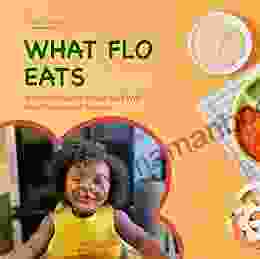
 Carlos Fuentes
Carlos FuentesThe Ultimate Guide to Healthy Eating for Toddlers: Meal...
As a parent of a...

 Peter Carter
Peter CarterInside My Autistic Mind: A Journey of Self-Discovery and...
Autism spectrum disorder (ASD) is a...

 Isaac Asimov
Isaac AsimovA Journey Through Jane Austen's Literary Masterpieces:...
Jane Austen, the renowned English...

 Hank Mitchell
Hank MitchellAdvancements in Textiles: Science and Technology by...
The textile...
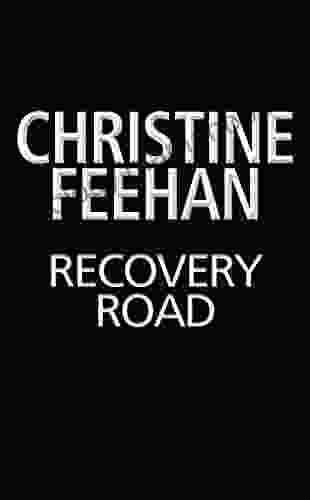
 Troy Simmons
Troy SimmonsRecovery Road: An Odyssey of Hope and Redemption by...
Recovery Road is a...
5 out of 5
| Language | : | English |
| File size | : | 61057 KB |
| Text-to-Speech | : | Enabled |
| Enhanced typesetting | : | Enabled |
| Word Wise | : | Enabled |
| Screen Reader | : | Supported |
| Print length | : | 320 pages |
| X-Ray for textbooks | : | Enabled |


